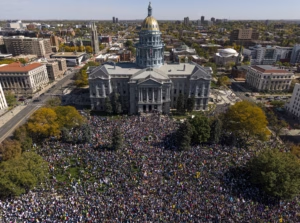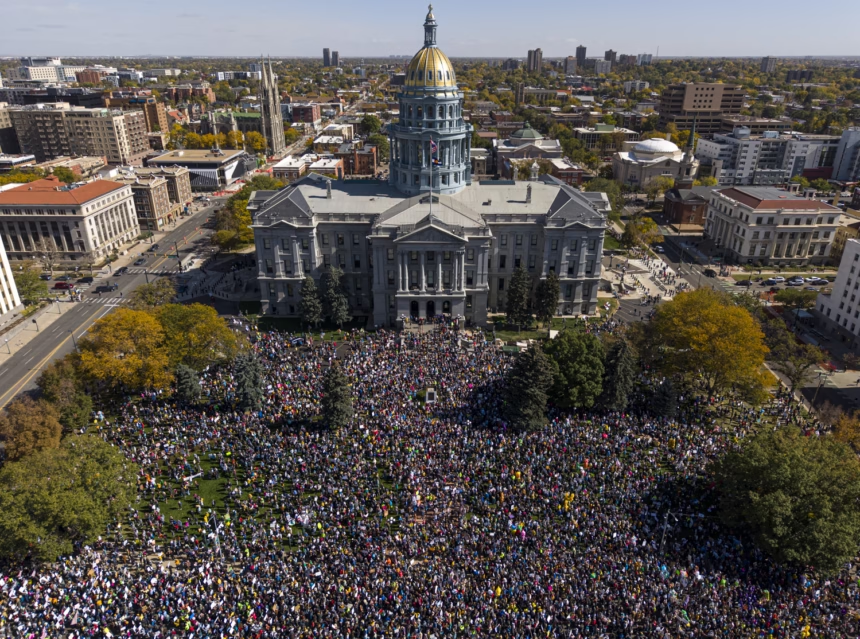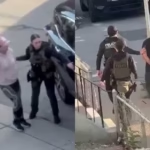Vast crowds marched across the United States on Saturday in “No Kings” demonstrations, unified in denouncing what participants described as a dangerous drift toward authoritarianism under President Donald Trump. Protesters cited federal immigration enforcement, the deployment of troops in American cities, and federal budget cuts, especially in health care, as key threats to democracy and the principles they seek to defend. These nationwide protests drew nearly 7 million participants, galvanized by grievances against what they see as an erosion of democratic values amid a tense political backdrop, exemplified by the ongoing government shutdown.
Across all 50 states, organizers reported nearly 7 million participants at over 2,700 events. While demonstrations varied in size, local police departments described the day as largely peaceful, with several major cities experiencing no arrests or incidents, CNN noted.
In Chicago, a city described as an epicenter of immigration enforcement, thousands demonstrated, many holding signs such as “Hands Off Chicago.” Protesters waved inverted American, Mexican, and Pride flags, highlighting concerns about ongoing immigration raids and proposed Medicaid cuts. This local focus on immigration enforcement serves to underscore the broader theme of federal power concentration. Demonstrators view these raids as emblematic of the increasing reach of federal authority, which they argue poses a threat to democratic principles across the nation.
In Los Angeles, at least ten demonstrations took place throughout the day, all remaining peaceful, Mayor Karen Bass said. Around City Hall, the rhythmic beats of salsa bands echoed against the towering government buildings, creating a contrasting backdrop to the serious message of the protests. Inflatable costumes and the vibrant colors of Mexican, rainbow, and American flags filled the area, giving the gathering the feel of a street festival.
A protester dressed as a unicorn said he chose the costume because it “exemplifies the diversity and culture of Los Angeles.” Pushing back on how some officials have characterized the protests, he added: “It’s really hard to call something a war zone when what you’re seeing looks like a block party, with people in Halloween costumes. Here, we take care of ourselves. We don’t need ICE or any other outside authority; these are people voicing their opinions and making sure those in power hear them.”
Asked by CNN to summarize the day, Bass said: “We know he (President Trump) is not a king. These protests are a stand against the slide toward authoritarianism. That is what unites this movement.” Bass referred to the federalization of the National Guard in Los Angeles over the governor’s objection as especially “frightening,” reinforcing the message: “We do not want military intervention in our cities normalized; that is a step backward toward authoritarianism. Americans are standing up across the country in thousands of protests—but peacefully. That is absolutely essential.”
New York and Washington: long-standing voices and new anxieties
At Times Square, already teeming with people, the crowd stretched several blocks toward Lower Manhattan. One demonstrator, who said she has been protesting since the 1960s, carried a sign reading: “We protest because we love America, and we want it back.” She noted the enduring spirit of activism that persists across generations, highlighting a continuity in civic engagement. Recent statistics suggest that although methods might have evolved with time, civic participation remains robust, with younger generations increasingly involved in digital advocacy and grassroots mobilization alongside traditional protest methods.
In Washington, along Pennsylvania Avenue on Day 18 of the partial federal government shutdown, current and former civil servants marched to call for a cooler political tone. This shutdown, caused by a contentious budget standoff between President Trump and Congress over federal spending priorities, has resulted in thousands of furloughs and a direct impact on government workers.
“One thing about the federal government is that it has helped many African Americans move into the middle class and buy their first homes in the Washington area. Eliminating all these jobs creates massive threats to keeping your home, keeping a roof over your head, sending your kids to college, and sustaining the hope of the American dream,” she said.
She described colleagues “in tears” after layoff announcements: “A lot of people are stressed. I was losing sleep, worried about how things were going and whether I would be able to keep my job… My children and co-workers have bills and want to survive; the turmoil is real.” She asked: “Can we survive three more years?”
Further west, in San Diego, police estimated more than 25,000 participants marched through downtown, demonstrating “peacefully and responsibly.” Lt. Travis Easter thanked the city in a video message: “Thanks for keeping it classy, San Diego.” This sentiment contrasted with other cities where heightened security measures were necessary, reflecting the varied approaches of law enforcement during these nationwide protests.
In the South, Charlotte, Austin, and Atlanta saw similar outcomes where authorities highlighted the respectful nature of the protests. In Charlotte, authorities announced that all streets had reopened with no arrests during the protest. Police praised attendees for contributing to a safe and respectful gathering. In Austin, thousands marched in front of the Texas Capitol. Police shared a photo of officers leading demonstrators, expressing gratitude to organizers and the community for conducting a safe, respectful protest. In Atlanta, the march emphasized the city’s civil-rights legacy, maintaining a peaceful yet urgent tone in defense of democracy.
Personal testimonies
Peggy Cole, a retired civil servant from Flint, Michigan, marked her 70th birthday by joining the rally in Washington. She said, “The president is taking our government, our democracy, and dismantling it piece by piece. If we sit by and do nothing…”
Elizabeth Nee, 25, a Baltimore social worker, said, “I think our democracy is at risk, and that is extremely distressing.” She described seeing many unhoused people and Medicaid recipients and added, “Everything that supports mental health is being dismantled—that’s my field. It’s scary.”
The day’s protests unfolded in the context of an ongoing budget standoff between the White House, Republican lawmakers, and the opposition, resulting in a partial federal government shutdown. On the West Coast, California briefly closed a stretch of Interstate 5 for a U.S. Armed Forces demonstration at Camp Pendleton—an event unrelated to the marches but one that impacted traffic, CNN reported.

By the newsroom — Based on CNN reporting.







